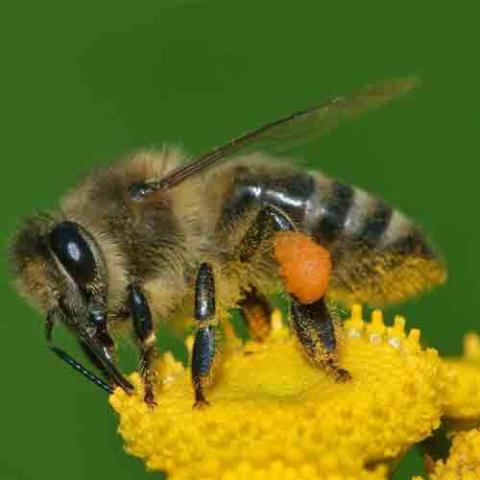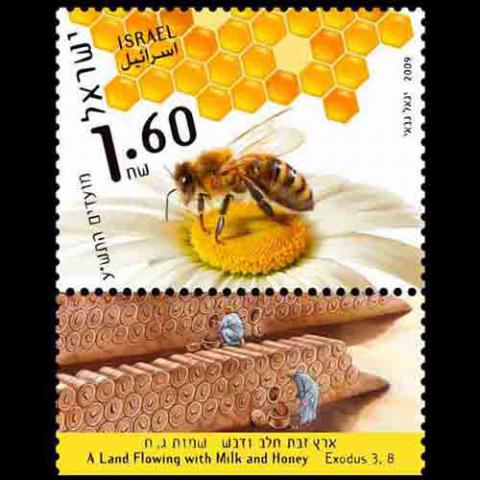Genus species: Apis mellifera
Series: Festivals (Israel 2009)
Honey is considered to be one of the tastiest foods and, along with milk, has frequently served as an allegory for things that are good and desirable. When the Torah wished to glorify the Land of Israel, it was said to be a “Land Flowing with Milk and Honey” and the author of the Song of Songs described the beloved wife by saying “honey and milk are under your tongue”.
The stamp series depicts the sweet delicacy’s journey from the flower in the field to people’s tables.
Bees produce honey from floral nectar that they gather and store in a special organ in their bodies called “honey stomachs”. The nectar is brought to the hive and transferred among the bees, eventually reaching the hexagonal wax honeycomb cells. There, through much ventilation and aided by enzymes, the bees turn the nectar into sticky liquid honey.
A large portion of the honey collected in the hive’s honeycombs is used to feed the adult bees and the larvae hatched from the eggs laid by the Queen Bee. The excess honey is collected by the human beekeeper and utilized as a healthy and nourishing food.
Jewish tradition considers the honey’s sweetness to be a sign of a good future and has created a number of customs related to it. Thus, for example, some Jewish ethnic groups customarily give a child a bit of honey when he begins studying the Torah, symbolizing the sweetness of his learning. During the feast on Rosh Hashana Eve it is customary to eat a slice of challah or a piece of apple dipped in honey and to recite the blessing, “May it be Your will to favor us with a good and a sweet year”.
The stamp tabs depict important milestones in the raising of honeybees in Israel.
People originally gathered honey from nature, collecting it from hives belonging to wild bees. Later, after having learned the ways of bees, people began to build hives, populate them with bees and care for them. Archeological excavations in Tel Rehov in the Beth-Shean Valley have recently unearthed beehives used in the ancient beekeeping industry dating to the period of the Israelite monarchy in the 10th-9th centuries BCE. The hives, made of elongated mud cylinders, are the only ones discovered to date in archeological excavations of the Ancient Near East. The hives were studied by Prof. Amihai Mazar and Dr. Nava Panitz-Cohen. The drawing of the hive that appears on the tab of the first stamp is based on a black and white sketch by painter Anna Iamim, which was adapted and colored by artist Tuvia Kurtz.
In 1886, Reuven Lerer, founder of the town of Ness Ziona, re-established the raising of bees among the Jewish settlers of Eretz Israel. Along with his son Moshe, he learned how to craft mobile hives consisting of wooden frames and attached honeycombs. They founded a honey farm that hosted some 200 hives at its peak. The tab of the second stamp features Moshe Lerer as he collects honey with his wife Pearl. The picture is based on a photo of the Lerer family, as adapted and colored by Tuvia Kurtz.
Today, the raising of bees constitutes an important agricultural field in Israel, providing income for hundreds of growers. Some 100,000 hives are scattered throughout Israel, producing more than 3,500 tons of honey each year. Modern hives, placed along the edges of a field of flowers, appear on the tab of the third stamp, as the beekeeper, clad in customary protective clothing, collects the honey from the hive.
Catalog codes:
- Michel IL 2077
- Yvert et Tellier IL 1986
- Stanley Gibbons IL 1954
- Israel Philatelic Federation IL 2027
Emmission: Commemorative
Perforation: comb14 x 13¾
Printing: Offset lithography
Colors: Multicolor
Face value: 1.60 ₪ - Israeli new shekel
Reference: israelphilately.org.il,colect.com
Shop now link: ebay.com (note: market availability)


